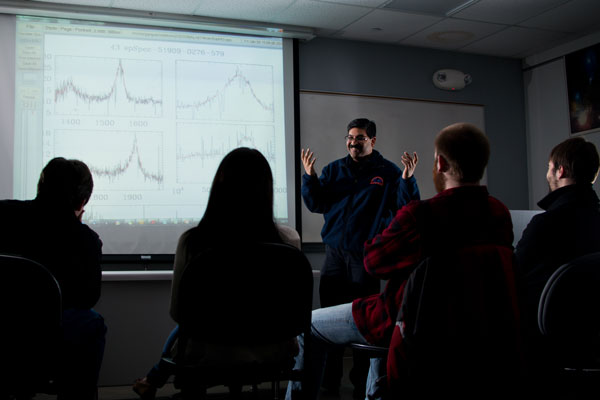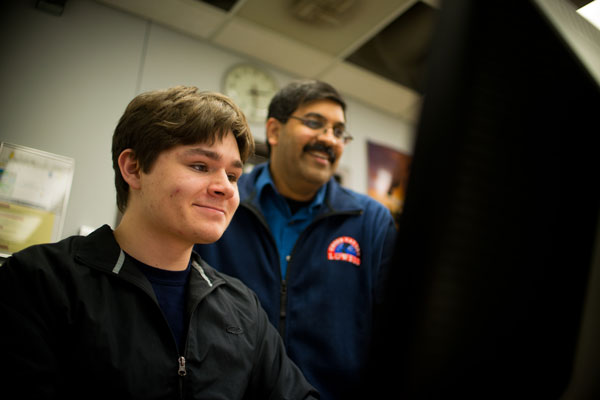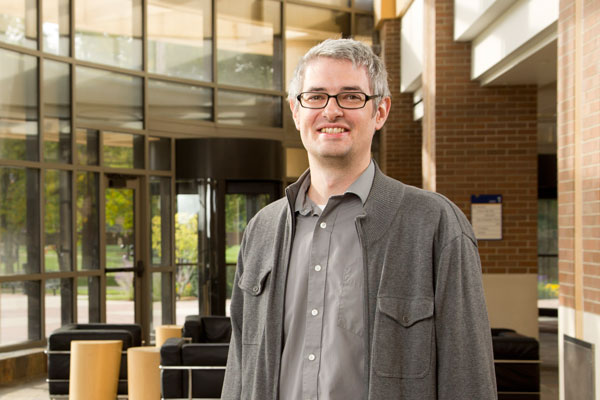Q & A: UM-Flint Physics Professors Discuss Impact of Gravitational Wave Discovery on Their Research

UM-Flint physics faculty members Rajib Ganguly, PhD and James Alsup, PhD answer questions about the recent discovery of gravitational waves. Both Ganguly and Alsup have focused their research on black holes and rely on Einstein's general theory of relativity, which predicted the existence of gravitational waves. Here, the professors offer an overview of the discovery, their initial reactions, and its implications.
Can you explain to the non-scientific community what are gravitational waves?
(Ganguly): Our ideas regarding the measurement of space (e.g., with a ruler) and time (e.g., with a stop-watch) came under fire at the turn of the century when Einstein (and company) realized that these could not reconcile how measurements of the speed of light gave exactly the same answer regardless of how fast the observer was moving relative to the beam of light. This requires a rethinking of the very nature of these two quantities and out of that thinking came a radically new concept.
The merger of these as not-independent things: spacetime. Einstein's further explorations regarding this quantity and the nature of gravity led to an idea this this thing could be distorted, warped, stretched, folded, bent by the presence of matter.
To explain this thing, this spacetime, we can use an analogy of a large sheet of stretchy fabric like spandex. If we place a bowling ball in the middle of that fabric, the fabric with stretch, and there will be a depression where the bowling ball sits. This is a reasonable visualization of a spacetime that has only two dimensions of space.
This visual provides a more tangible feeling for not only spacetime, but the nature of gravity itself. Gravity, one of the fundamental forces of nature, is a bending of the fabric of spacetime.
Now imagine that there are two bowling balls in orbit around each other. Depending on where you sit, how much the fabric of spacetime is stretched (i.e., how strong gravity is) will change. But how quickly will those changes be transmitted to your location? Will you notice an instantaneous change in how the fabric around you is stretched? Einstein showed that the answer is no. That information travels at the speed of light, which is fast, but not infinite. Changes in gravity, or changes in how the fabric of spacetime is warped, travel at a finite speed. This is the essence of a gravitational wave.
Why is this discovery such a big deal?
(Ganguly): There are several reasons why it is a big deal.
First, it is a direct prediction from Einstein's ideas about gravity. Using those ideas, he predicted that the planet Mercury's orbit should precess. It does. He predicted that light, even though it has no mass, should still be affected by gravity. It does. We can see it in the form of gravitational lenses. But these are, more or less, things that happen in a static situation. In a dynamic situation, he predicted that spacetime should ripple, and those ripples, like waves on the surface of a pond should travel to transmit information from one place to another. As of September 14, 2015, the day the observation took place, we've confirmed that it does.
Second, the result for actually testing this final prediction is the culmination of four decades (ten presidential terms) of groundbreaking technology development, and vigilant research. This time scale essentially spans most of the careers of many scientists. To give you an idea of the investment from a human perspective, the paper published regarding this result was 16 pages long. Four of those pages was the list of people who contributed to making this happen. Three of them are deceased. They contributed to a cause and did not even live to see the fruits of their labor. And everyone one of those people will tell you that every minute was worth this one result, the first of many.
Finally, and you next question gets into this so I'll save the more detailed answer, this is a game changer for how we can proceed in the future of astronomical research.

How does this discovery change the field of physics? What are the implications of this?
(Ganguly): About 407 years ago, Galileo first used a telescope to look at objects in space (Jupiter and Venus) and actually study them courtesy of the light that we get from those objects. This effectively separated the science of astronomy from the pseudo-science of astrology. In effect, he taught us to "see" the Universe, not as we want it to be, but as it is.
As humans, we are used to collecting information about the world around us using five senses – sight, hearing, taste, smell, and touch. In astronomy, we can only see things. We can't hear them. We can't smell them, taste them, or touch them. All that has changed. As of September 14, 2015, we can now hear the Universe speaking to us. And Einstein gave us a language with which to understand what it is saying. It opens up, literally, a whole new Universe of possibilities. A new way of asking questions. A new way of learning. A way that complements what we can see. A hundred years from now, astronomers will wonder how we ever got as far as we did with just sight, in the same way that we wonder how the Greeks got as far as they did without the use of a telescope. It is that profound.
Can you explain your background, work and research, and how this news impacts your research and work?
(Ganguly): I'm an astronomer, and an astrophysicist. The differences between those are not important here. But my interest is understanding how the largest black holes in the Universe came to be, and how their growth affected their surroundings. I use light from across the electromagnetic spectrum to study how this happens. Everything from the Hubble Space Telescope, to ground based telescopes, from radio wavelengths, to visible wavelengths, to X-rays. The whole gambit. We have very good ideas about how black holes are born from the death throes of the most massive stars. But we have little information about how to get those black holes to the size of the ones I study. The detection of the merger event in a binary black hole system is exactly a piece to that puzzle. And we could only have detected it with LIGO. The event that was recorded has been looked at in the X-ray, in the ultraviolet, and in the visible. There is no sign of it. This is something that we must "listen" for, because we can't "see" it happening.

(Alsup): I was preparing for my introductory physics class when I tuned into the announcement. It caught me a little by surprise and I was moved more than I expected. I had heard the rumors, but I had heard rumors in previous years. I had no choice but to spend the first 20 minutes of class trumpeting the success of Einstein's theory to my class. I assume it was more exciting than friction. The past few years have been kind to physics. We have been able to celebrate the Higgs boson findings and now gravitational waves findings.
Should the general public be excited about this, and if so, why?
(Ganguly) Of course. This is not just a novel new thing like flying by an object that everyone loves and taking close-up pictures of it for the first time. This is science at its absolute finest. You have an idea. You figure out a myriad of ways to test it. And you do it. If your ideas fail, then it is back to the drawing board. Otherwise, we have more confidence in the applicability of that idea. We've learned something about nature. Sometimes testing the idea requires a lot of meticulous data crunching. Sometimes it takes the development of a whole new way making the measurements. Sometimes it takes a new way of carrying out the experiment. This required all of the above. Every person who is interested in science, or technology, or engineering, or mathematics should pay attention to the details. Everyone else should appreciate that we have a new way of collecting information about the Universe – not just by looking at the Universe, but actually hearing it. If one could hear Leonardo Da Vinci as he was painting the Mona Lisa, or Michelangelo as he was sculpting David, would we be asking why we should be excited?
Related Posts
No related photos.
- College of Arts, Sciences & Education
- Engineering
- Faculty
- Mathematics
- Physics
- Q & A
- Research
- University News
UM-Flint News
The Office of Marketing & Communications can be reached at mac-flint@umich.edu.